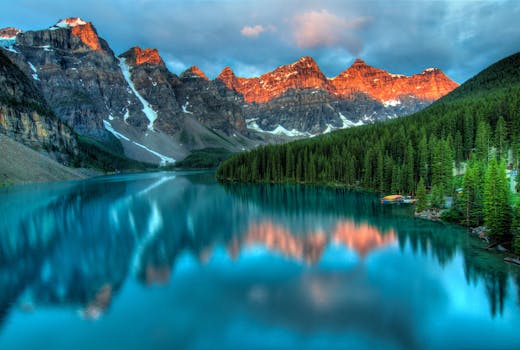The Most Scenic National Parks in the USA

The United States boasts an impressive array of national parks, each offering unique and breathtaking landscapes. From towering mountains to vast deserts, these protected areas provide visitors with unparalleled opportunities to connect with nature. Exploring these scenic national parks not only offers a chance to witness the beauty of the natural world but also to learn about the diverse ecosystems and cultural histories preserved within their boundaries.
1. Yellowstone National Park
Yellowstone National Park, established in 1872, is renowned as the first national park in the world. Spanning across Wyoming, Montana, and Idaho, it covers an area of over 2.2 million acres. The park is famous for its geothermal features, including the iconic Old Faithful geyser and the vibrant Grand Prismatic Spring.
Visitors can explore an extensive network of trails that lead to waterfalls, hot springs, and diverse wildlife habitats. The Lamar Valley is a prime spot for observing bison, elk, and wolves in their natural environment. Additionally, Yellowstone Lake offers opportunities for boating and fishing amid stunning mountain vistas.
The park's geothermal activity is a result of its location atop a volcanic hotspot. This unique geological feature has shaped the landscape over millions of years, creating a dynamic and ever-changing environment that continues to captivate scientists and tourists alike.
2. Grand Canyon National Park
Grand Canyon National Park in Arizona is one of the most iconic natural landmarks in the United States. Carved by the Colorado River over millions of years, the canyon stretches 277 miles in length and reaches depths of over a mile. Its immense size and intricate rock formations leave visitors in awe.
The South Rim is the most accessible part of the park, offering numerous viewpoints such as Mather Point and Yavapai Observation Station. These vantage points provide panoramic views of the canyon's vast expanse, showcasing layers of red rock that reveal a geological history dating back nearly two billion years.
For a more immersive experience, visitors can hike into the canyon on trails like Bright Angel or South Kaibab. Rafting trips on the Colorado River offer another perspective, allowing adventurers to navigate through the canyon's rapids while surrounded by towering cliffs.
3. Great Smoky Mountains National Park
Straddling the border between North Carolina and Tennessee, Great Smoky Mountains National Park is renowned for its biodiversity and mist-covered peaks. It is the most visited national park in the United States, attracting millions of visitors each year.
The park features over 800 miles of hiking trails, including a section of the famous Appalachian Trail. Cades Cove is a popular destination within the park, known for its historic buildings and abundant wildlife sightings, including black bears and white-tailed deer.
The Great Smoky Mountains are part of an ancient mountain range that dates back over 200 million years. The lush forests are home to more than 19,000 documented species of plants and animals, making it one of the most ecologically rich areas in North America.
4. Yosemite National Park
Located in California's Sierra Nevada mountains, Yosemite National Park is celebrated for its stunning granite cliffs, waterfalls, and giant sequoia trees. The park spans over 1,200 square miles and offers diverse recreational opportunities.
Yosemite Valley is home to some of the park's most famous landmarks, including El Capitan and Half Dome. Visitors can explore these iconic formations through various hiking trails or enjoy rock climbing on some of the world's most challenging routes.
The Mariposa Grove contains over 500 mature giant sequoias, some of which are more than 2,000 years old. These towering trees are among the largest living organisms on Earth and provide a humbling experience for those who visit them.
5. Zion National Park
Zion National Park in Utah is known for its dramatic sandstone cliffs and narrow canyons. The park's unique topography creates an array of landscapes that range from desert terrain to lush river valleys.
The Zion Canyon Scenic Drive offers breathtaking views and access to popular hiking trails such as Angels Landing and The Narrows. These trails provide challenging yet rewarding experiences with stunning vistas at every turn.
Zion's geology tells a story that spans hundreds of millions of years. Layers of sedimentary rock have been eroded by wind and water to create the striking formations seen today. The Virgin River continues to shape this landscape, carving deeper into the rock with each passing year.
Comparison Table: Key Features of Highlighted National Parks
< td >Hiking,canyoneering
| National Park | Location | Key Features | Notable Activities |
|---|---|---|---|
| Yellowstone | Wyoming/Montana/Idaho | Geothermal features, wildlife | Hiking, wildlife watching |
| Grand Canyon | Arizona | Canyon views, Colorado River | Hiking, rafting |
| Great Smoky Mountains | North Carolina/Tennessee | Biodiversity, mist-covered peaks | Hiking, wildlife watching |
| Yosemite | California | Granite cliffs, waterfalls giant sequoias | Hiking,rock climbing |
| Zion | Utah | Dramatic sandstone cliffs,narrow canyons |
The national parks highlighted in this article represent just a fraction of America's natural treasures.